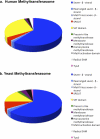Uncovering the human methyltransferasome
- PMID: 20930037
- PMCID: PMC3013446
- DOI: 10.1074/mcp.M110.000976
Uncovering the human methyltransferasome
Abstract
We present a comprehensive analysis of the human methyltransferasome. Primary sequences, predicted secondary structures, and solved crystal structures of known methyltransferases were analyzed by hidden Markov models, Fisher-based statistical matrices, and fold recognition prediction-based threading algorithms to create a model, or profile, of each methyltransferase superfamily. These profiles were used to scan the human proteome database and detect novel methyltransferases. 208 proteins in the human genome are now identified as known or putative methyltransferases, including 38 proteins that were not annotated previously. To date, 30% of these proteins have been linked to disease states. Possible substrates of methylation for all of the SET domain and SPOUT methyltransferases as well as 100 of the 131 seven-β-strand methyltransferases were surmised from sequence similarity clusters based on alignments of the substrate-specific domains.
Figures





Similar articles
-
Multiple Motif Scanning to identify methyltransferases from the yeast proteome.Mol Cell Proteomics. 2009 Jul;8(7):1516-26. doi: 10.1074/mcp.M900025-MCP200. Epub 2009 Apr 7. Mol Cell Proteomics. 2009. PMID: 19351663 Free PMC article.
-
Structural and evolutionary bioinformatics of the SPOUT superfamily of methyltransferases.BMC Bioinformatics. 2007 Mar 5;8:73. doi: 10.1186/1471-2105-8-73. BMC Bioinformatics. 2007. PMID: 17338813 Free PMC article.
-
Comprehensive structural and substrate specificity classification of the Saccharomyces cerevisiae methyltransferome.PLoS One. 2011;6(8):e23168. doi: 10.1371/journal.pone.0023168. Epub 2011 Aug 9. PLoS One. 2011. PMID: 21858014 Free PMC article.
-
Structure, function, and inhibition of O6-alkylguanine-DNA alkyltransferase.Prog Nucleic Acid Res Mol Biol. 1995;51:167-223. doi: 10.1016/s0079-6603(08)60879-x. Prog Nucleic Acid Res Mol Biol. 1995. PMID: 7659775 Review. No abstract available.
-
Protein lysine methylation by seven-β-strand methyltransferases.Biochem J. 2016 Jul 15;473(14):1995-2009. doi: 10.1042/BCJ20160117. Biochem J. 2016. PMID: 27407169 Review.
Cited by
-
How Protein Methylation Regulates Steroid Receptor Function.Endocr Rev. 2022 Jan 12;43(1):160-197. doi: 10.1210/endrev/bnab014. Endocr Rev. 2022. PMID: 33955470 Free PMC article. Review.
-
Dietary-derived vitamin B12 protects Caenorhabditis elegans from thiol-reducing agents.BMC Biol. 2022 Oct 8;20(1):228. doi: 10.1186/s12915-022-01415-y. BMC Biol. 2022. PMID: 36209095 Free PMC article.
-
SARS-CoV-2 Nsp16 activation mechanism and a cryptic pocket with pan-coronavirus antiviral potential.Biophys J. 2021 Jul 20;120(14):2880-2889. doi: 10.1016/j.bpj.2021.03.024. Epub 2021 Mar 29. Biophys J. 2021. PMID: 33794150 Free PMC article.
-
From histones to ribosomes: a chromatin regulator tangoes with translation.Cancer Discov. 2015 Mar;5(3):228-30. doi: 10.1158/2159-8290.CD-15-0073. Cancer Discov. 2015. PMID: 25749972 Free PMC article.
-
Age-dependent decrease and alternative splicing of methionine synthase mRNA in human cerebral cortex and an accelerated decrease in autism.PLoS One. 2013;8(2):e56927. doi: 10.1371/journal.pone.0056927. Epub 2013 Feb 20. PLoS One. 2013. PMID: 23437274 Free PMC article.
References
-
- Cheng X., Blumenthal R. M. (eds) (1999) S-Adenosylmethionine-dependent Methyltransferases: Structures and Functions, World Scientific, Singapore
-
- Martin J. L., McMillan F. M. (2002) SAM (dependent) I AM: the S-adenosylmethionine-dependent methyltransferase fold. Curr. Opin. Struct. Biol. 12, 783–793 - PubMed
-
- Katz J. E., Dlakić M., Clarke S. (2003) Automated identification of putative methyltransferases from genomic open reading frames. Mol. Cell. Proteomics 2, 525–540 - PubMed
Publication types
MeSH terms
Substances
Grants and funding
LinkOut - more resources
Full Text Sources
Other Literature Sources

